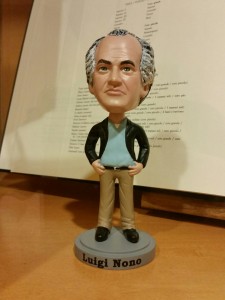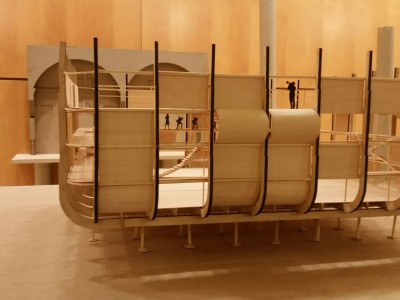Utopian Listening: Reinvigorating Nono in America
|
Grant Chu Covell [April 2016.]
Years from now, we will look back at a conference held in Boston at the end of March 2016 as the defining event that reinvigorated worldwide – American especially – interest in the work of Luigi Nono. Post-1945 music history has been written and digested, and for predominantly political reasons Nono has been unfairly sidestepped. I recall the prevalent dismissive attitude from my own undergraduate studies: Nono was disparaged not just because he flew the serialist coop but also because he had, ahem, Communist tendencies! Later, I discovered on my own that Nono wrote music of exceptional fortitude, and that he had created some of the most passionate and straightforward music ever. Between March 23 and 26, die-hard performers and scholars including several super luminaries such as Nuria Schoenberg Nono, Arnold’s daughter and Nono’s widow, gathered at Tufts University (Medford, MA) to talk about, interpret and listen to Nono’s music. Even New England’s especially fickle weather abetted, providing overcast skies and occasional drizzle in a meager attempt to simulate Venetian fog. I spent most of my time at the major concerts which offered mesmerizing and profoundly intense experiences. It was probably the best trio of concerts I will hear all year. Having been a Nono fan for decades, it was a chance to see and hear several pieces I know only through recordings. Nono died in 1990, and this conference, sponsored jointly by Tufts and Harvard, focused upon the Italian’s later electroacoustic works and included workshops where musicians and attendees discussed practical and aesthetic aspects of interpretation and performance. Nono’s late works coincide with his final decade, starting with the string quartet, Fragmente – Stille, An Diotima (1980), which marked the beginning of quieter, sparer music and a heightened sense of the sounds produced which in many cases are enhanced with live electronics. Arguably, these later works are among the more difficult to realize of Nono’s oeuvre, not just because they may require electronics or tapes, but because their notation can be imprecise. Electronics and tape playback are common today, but back in the 1980s Nono was an innovator, and these pieces came about through close collaboration between composer, performers, technicians and even site architects. There are scores, but they may lack the original details. This conference took aim at such perceived obstacles, as here was a fresh generation of interpreters staking out performances that acknowledged the originals but also confidently responded to Nono’s intentions. Presenting Nono’s art can only get easier hereafter. Three concerts were spread across two venues, including Tufts’ acoustically fine Distler Performance Hall. On the first night (Friday, Mar 25), Alvise Vidolin, a longtime Nono and Sciarrino collaborator, turned the dials for the potent tape work Ricorda cosa ti hanno fatto in Auschwitz (1966). Sure, you could listen to it at home, but not in a filled-to-capacity room with eight speakers and the lights turned low so that the brusqueness startles. The same setup (with lighting) was used brilliantly on two successive nights for La lontananza nostalgica utopica futura (1988) with Miranda Cuckson, violin, and Christopher Burns at the controls. La lontananza has been discussed lengthily before, however nothing matches actually seeing the violinist wander from stand to stand, and hearing caustic violins jump out of the speakers. As the occasional virtuosic bits bounced around (I detected Gidon Kremer’s noodling on Tchaikovsky and Ysaÿe), Cuckson intently sought out music to play. I found the repeat on Saturday, Mar 26, the more satisfying, but I’m picky. Regardless, it thrilled immensely to hear different paths through the same material delivered by a team who knows the work so well. I maintain that Nono was embarking on something new in this piece, but also was aware of his own mortality. La lontananza brings its own audience noise (Kremer and Nono talking, music stands dragging, things dropping, trains passing, etc.) which makes live performance all the more intriguing, and frankly unsettling. On Friday night I sat next to folks who were clearly uncomfortable as their dismay led to giggling. The first night also brought a concentrated delivery of La fabbrica illuminata (1964) for voice and tape. Stacey Mastrian, soprano, confidently took to a bare stage while Peter Plessas ensured the taped sounds of an adamant chorus and a noisy factory whirled around her. The evening concluded with perhaps one of the most obtuse Nono constructions to comprehend on recording, Post-prae-ludium n. 1 per Donau, for tuba and live electronics. Max Murray was essentially pinned to the stage as a microphone was lowered close to his instrument’s bell. The electronics are expertly crafted delays, and both engineer (Joshua Fineberg) and musician must emit a precise series of sounds and pitches to create diffuse strata. Now that I’ve seen it twice (it was repeated on Saturday night), it makes so much more sense. The next morning (Saturday, Mar 26), we heard the North American premiere of Das atmende Klarsein (1981). Admittedly the unusual combination of bass flute, small chorus and electronics might have discouraged stateside programming; however, it smarts to realize this piece had to wait 35 years to be heard on these shores. Claire Chase took on the bass flute part, and the 11 members of Triad: Boston’s Choral Collective provided the voices. David Harris conducted and Hans Tutschku sat at the mixing desk. The morning began with A Pierre. Dell’azzurro silenzio, inquietum (1985), which calls for contrabass flute, contrabass clarinet and live electronics. Chase and Tutschku were joined by clarinetist Evan Ziporyn. Chase conquered the monstrous flute, shaped like a gigantic metallic number four, which elicited sultry low tones. Ziporyn too contributed deep rasps from his oversized instrument, and together breathy overtones encircled a rapt audience. One must watch the players exert themselves to understand what is live and what might be delay. Does it suggest Boulez? It’s hard not to think of Répons, and immediately it dawns that Nono has created the subtler, more humane and more elegant work. It was gratifying to hear a particular favorite, …sofferte onde serene… (1976), for piano and tape (Julia den Boer, piano, and Peter Plessas, sound diffusion), in this context (Saturday eve, Mar 26). With loudspeakers parked behind the Steinway grand and knowing that Nono wrote the piece for Maurizio Pollini to mark losses in both their families, the infrequent prerecorded knocking of the instrument case suggested scratching from the inside of a coffin. Sofferte is funereal with its obscured Venetian bells and dissonant, arrhythmic piano clusters. It never fails to impress; Pollini’s recording was probably what set me on the path to Nono fanaticism. There really are ghosts in some of these pieces. Some titles refer to Nono’s friends and colleagues: A Pierre indicates Boulez, other works discussed across the four days but not played live commemorate Dallapiccola and Kurtág. The tapes of Das atmende Klarsein and sofferte capture the original collaborators, Roberto Fabbriciani and Pollini respectively, and as already remarked, La lontananza embeds Kremer and Nono himself. Time has perhaps softened the impact of the few political pieces presented. The anger seething through the Varèsian Ricorda cosa ti hanno fatto in Auschwitz is eminently palpable, and we must note Nono’s title: “Remember what they did to you in Auschwitz.” Pre-recorded voices, instruments and electronic sounds are perhaps more commonplace today, but Ricorda still has the ability to amaze and threaten. Decades have passed since the other mid-1960s piece, La fabbrica illuminata (“The illuminated factory”), whose texts documenting worker abuse seem more like a faded newsreel rather than a contemporary denouncement.
Spread around the conference spaces, in some cases playing through specially designed wireless speakers, was an installation curated by John Ellis and his colleagues and students; it included a repeating video combining Venetian imagery and recitations of texts used by or responding to Nono’s work. In the lobby of the hall sat a model I’d seen before in Venice at the Nono Archive, Renzo Piano’s vessel-shaped performance structure for Prometeo. These installations were necessary reminders that environment is a critical component in Nono’s art. Prior to the final concert, I jotted down some impressions. However, upon rereading, I hadn’t expressed anything at all about the music. All I had were feeble remarks about the location, perceived attitudes of the attendees, or random thoughts as a conference voyeur. I’m grateful to have heard about the event, that Tufts and Harvard did such a great job putting it together, and that I could literally wander through it anonymously among the other practitioners, explorers and fellow “Caminantes.” Today we have digital tools far superior to finicky mechanical reel-to-reel tape decks. There are plug-and-play software and storage modules that permit easy creation of delays, spatialization and amplification. I suspect Nono would have taken this in stride and then progressed to a new frontier of quieter but more intense sounds. The 1980 string quartet marks the transition into this period, but most of the late pieces with live electronics require instruments that breathe (winds, brass) and not strings. At the end of his life Nono returned to strings (La lontananza nostalgica utopica futura for violin and tapes in 1988, “Hay que caminar” soñando for two violins in 1989, and there’s the rumor of an incomplete second string quartet), and I suspect he would have again wandered onto a new frontier. It’s evident that Nono scholarship is turning a corner. Collectively we understand the “text” of his works, and we can interpret them better now than ever before. I remain convinced that close listening explains more about the music than contextual historical studies do. This music is challenging, begs clarification and asks countless questions. Nono was plunged into the ideas of his times, and consequently it’s possible to divine a lengthy reading list for every gesture and remark. But we’re supposed to listen closely and openly. Understanding the music in context is valid and interesting, but the music, its titles and embedded texts speak for themselves. Nono tells us that listening can be political. By listening we are bearing witness. We may hear a poem or a story of injustice, and if we really hear and understand, we must heed the call to action and act upon our newfound knowledge. We may perceive single tones that wobble and spin, or dissonant intervals that climb and whirl; here too, we must return to the world as better listeners, and learn from Nono as we wander.
[In connection with Nono’s Auschwitz piece, I cannot fail to cite a great book – Dying We Live: The Final Messages and Records of the Resistance (Pantheon, 1956). W.M.]
[More
Nono]
[Previous Article:
(Dis)Arrangements 7: Beethoven]
[Next Article:
Diary of a Pianist's Day]
|

